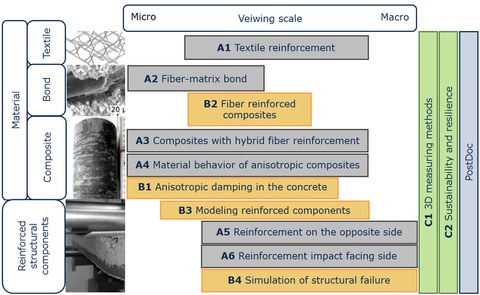Research subjects
In order to achieve highly ductile, extremely energy-absorbing material and structural behavior under impact stress, new material concepts and reinforcement types have to be developed,. The basis of this development is strain-hardening short fiber reinforced concrete (SHCC) with a tensile elongation of more than 5% under quasi-static load as well as flat and spatial reinforcement structures from continuous fiber bundles (A1). The combination of textile structures and short fibers (hybrid fiber reinforcements) is also very promising (A3). A goal-oriented design of the new composites’ properties under high strain rates is to be achieved by fundamental, multiscale, experimental and theoretical-numerical interdisciplinary investigations. The characterization of the new materials with predominantly anisotropic material behavior requires the design and implementation of new highly dynamic test and measurement techniques (A4, C1). The experimental work will proceed together with the development of new numerical approaches such as the multiscale simulation of the anisotropic damping behavior of fiber reinforced concrete under impact in the fine mesoscale (B1). The expansion of the developed numerical method by a bionic remodeling approach (B1) is intended to allow the calculation of an optimal reinforcement orientation. The interphase design also plays an important role for the fiber-matrix composite (A2) which is favorable in terms of the fracture behavior. Furthermore, significant improvements are expected from higher heterogeneity or an engineered composition of the matrix (A3). These conceptual-experimental developments are to be improved by the establishment of a physically motivated damage model for the description of the fiber pullout (B3).
In the development of reinforcement solutions using new composites, variants for their application are considered both on the impact-facing side (A5) and on the impact-opposite side (A6). Through this process natural principles of impact absorption with regard to their adaptability for reinforcement layers for Structural components should be examined (A6). The new impact-resistant composites and reinforcing systems should be developed and evaluated not only from an engineering but also from an economic and ecological point of view (C2).
In order to elaborate a deep understanding of the specific structural behavior under impact loading, theoretical and numerical models extending far beyond current knowledge are developed. An important role is played by the simulation of the bond between the fibers and the matrix under very high strain rates as well as the development of relevant constitutive laws (B2), which are also to be found in the numerical multiscale approach (B1). For the efficient and reliable simulation of the behavior of reinforced concrete structures under impact, solutions based on the micro-plane model are developed for a rate-dependent, dissipative and mesh-independent simulation (B4). The phenomenological (B2) and physical (B3, B4) designed approaches are developed and tested for their suitability for the characteristics to be described. Furthermore, the method of self-erosion is to be extended with a binary description for undamaged / damaged material in order to enable the realistic characterization of the heterogeneous material concrete with (hybrid) fiber reinforcement or reinforcing reinforced concrete (B4).

